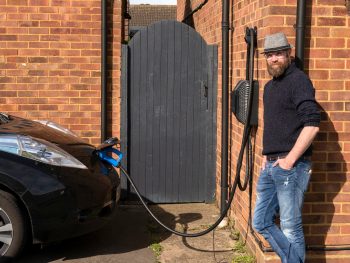V2G trial cuts grid stress and charging costs
A new trial has shown that using vehicle-to-grid (V2G) charging in tandem with other technologies can help to balance the grid despite the fast-rising number of EVs, while also cutting charging costs for drivers.

Richard Stidston was a participant in the Domestic Energy Balancing EV Charging project
The Domestic Energy Balancing EV Charging trial saw electric vehicle drivers in Milton Keynes test smart chargers and V2G chargers over the period of a year, while also involving households with solar PV panels installed.
V2G chargers channel energy between the grid and the user’s home and vehicle, and back again – importing and exporting energy based on the real-time demands of the energy network. This means that vehicles can be instructed to automatically charge when prices and carbon levels are low and can send power back to the grid to be sold when demand is high – while keeping enough for the needs of the driver.
The work showed that the combination of different technologies has the potential to reduce the load on the electricity grid from charging EVs, when used in conjunction with a smart charger and battery energy management platform.
The project also revealed that there is the potential for EV owners to save money on energy costs. By the end of the trial, charge cycles for some participants were at least 40% cheaper than unmanaged charging – but participants with V2G chargers were sometimes able to reduce their charging costs to zero by charging at cheap times and then powering their homes at expensive times. In total, participants saved a combined £2,242 during the trial – an average of £15 per user per month.
Participants were also able to regularly reduce the carbon emissions of their charging by at least 25% – and those with V2G technology were sometimes able to charge with zero emissions during periods when they could use 100% renewable energy, and discharge at periods of high carbon intensity.
The project was delivered by CrowdCharge on behalf of Milton Keynes Council, with Flexitricity as the energy demand response partner – and the firm say the findings will help the electricity industry to better manage the peaks in electricity demand caused by charging increasing numbers of electric vehicles.
The project also revealed important learning points, including that technologies such as battery storage are currently difficult to integrate into home energy systems; more work is needed to overcome this.
Mike Potter, CEO of CrowdCharge, said: “We’ve shown that different technologies can help prevent local electricity networks being overloaded, but the key is the intelligent management of such technologies. Successfully integrating these systems can mean that electric vehicle drivers can benefit from greener energy as well as energy cost savings.”
Cabinet Member for Climate and Sustainability Cllr Jenny Wilson-Marklew added: “We look forward to implementing what we’ve learnt as part of our range of initiatives in Milton Keynes to future-proof our infrastructure for electric vehicles.”
An assessment of the technologies used in the trial, and how they can work together effectively will be published later this year, with more details at: https://crowd-charge.com.
CrowdCharge is also offering the energy optimisation services that were trialled on the project, and has V2G users on its platform. It’s also due to launch a range of new dynamic energy (or ‘flexibility’) services in the UK energy market in the next two to three years.












